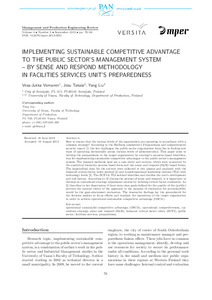Implementing Sustainable Competitive Advantage to the Public Sector’s Management System – By Sense and Respond Methodology in Facilities Services Unit’s Preparedness
Vornanen, Vesa-Jukka; Takala, Josu; Liu, Yang (2013-09)
Vornanen, Vesa-Jukka
Takala, Josu
Liu, Yang
Polish Association for Production Management
09 / 2013
Julkaisun pysyvä osoite on
https://urn.fi/URN:NBN:fi-fe2021042211426
https://urn.fi/URN:NBN:fi-fe2021042211426
Kuvaus
vertaisarvioitu
© 2013 The author(s). This article published under the terms of the Creative Commons Attribution-Non-Commercial-NoDerivs license (https://creativecommons.org/licenses/by-nc-nd/3.0/).
© 2013 The author(s). This article published under the terms of the Creative Commons Attribution-Non-Commercial-NoDerivs license (https://creativecommons.org/licenses/by-nc-nd/3.0/).
Tiivistelmä
How to ensure that the various levels of the organization are operating in accordance with a common strategy? According to the Hallberg committee’s Preparedness and comprehensive security report [1] the key challenges the public sector organization faces lies in finding new ways of operating horizontally across various levels of administration. This paper aims to develop the preparedness in the target organization by strategy’s resource-based identification for implementing sustainable competitive advantages to the public sector’s management system. The research methods used are a case study and surveys, which were connected by the analytical hierarchy process based form and two sense and respond (S&R) based forms.The longitudinal data for the surveys were collected in two phases and analyzed with the balanced critical factor index method [2] and transformational leadership indexes (TLI) with technology levels [3]. The BCFI & TLI method identifies and clarifies the unit’s development and risk factors. According to [4] during the process of sense and respond, it is important to develop an operational strategy adjustment system by utilizing critical factor evaluation. As [5] describes in her dissertation if there were clear goals defined for the quality of the (public)services the natural choice of the approach in the purpose of evaluation for accountability would be the goal-attainment evaluation. The innovative findings lay the groundwork for the decision makers to focus efforts and readjust the operations of the target organization in order to achieve operational sustainable competitive advantage (OSCA).
Kokoelmat
- Artikkelit [2621]
